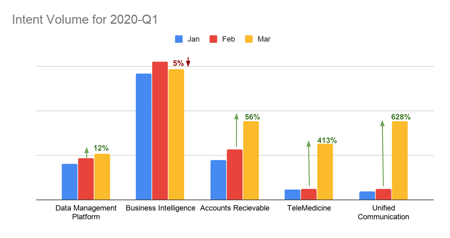Tl;dr - Just as some industries are surging while others are stagnant due to Covid measures, intent data results are fluctuating as well. Why? It might be your industry and target market. More likely, it's the data collection method that is encountering structural challenges in current (and likely ongoing) market conditions. #WFH and collapsing digital advertising might be to blame.
Don't Let Me Down Now Intent Data!
"There's something happening here
What it is ain't exactly clear"
For What It's Worth, Buffalo Springfield
The intent data industry has traditionally been a bit opaque. Data collection methods, accuracy and price have been hard for B2B marketers to nail down. Some of the opacity can be explained by protection of IP and trade secrets; some by competitive positioning; and some because purchase intent data technology emerged as a bit of a black box mystery.
Marketers have grudgingly accepted that.
Data worked. And marketers ran with it.
But big shifts appear to be underway. For many intent data users, volume is falling. In some cases the decline has been precipitous and particularly troublesome since it's happening just when they need the buyer intent data insights most. And that's got people asking not only what's changed, but more broadly seeking to understand how data works.
So what is happening here?
While we only have direct insight into our data (which hasn't seen significant across-the-board volume decrease) we have identified three factors in the broad decline in intent data volumes. They include:
- Work From Home IP Address Resolution Challenges
- Falling Advertising Volumes
- Market Changes
Let's unpack these one by one.
IP Address Resolution & #WFH
This one's pretty straightforward if you understand the collection methods of popular third-party intent data. Publishers in co-ops exchange anonymous information which is typically associated with companies based on IP address resolution. If most people are working from home, and only small portion are using corporate VPNs, then their activities are through community, shared, ISPs.
Ergo, there are no apparent company affiliations, and therefore, no useable data to report.
Simple.
End of story. (Although a bit more in the video and podcast episode if you want to dig in deeper - and our method works without relying on either IP address resolution, DSP data or third-party cookies)
Digital Advertising Is "Getting Absolutely Hammered"
That's Tien Tzuo's dramatic characterization of the situation.
But why does this matter to the volume of buyer intent data signals?
Another common intent data collection method is built on bidstream data that's harvested from DSPs (programmatic advertising Demand Side Platforms.) As ad volume falls, the amount of signal will fall in parallel. Most of the coverage around digital advertising has focused on how rates have fallen without much in the way of specific volume stats. In a supply/demand market, however, there's a clear and simple correlation.
While there's lots of industry buzz about the propriety of bidstream sourced intent data (it's harvested for monetization in a way that almost none of the publishers or advertisers have opted in to, or informed their visitors of) one of the advantages cited by bidstream data vendors is volume. So the decrease in bidstream data volumes may not be as apparent as with methods that rely primarily on IP address resolution, but it's there. And with the questions on accuracy and noise still applicable, the reduction even further attenuates reliable signal.
What's Happening in Your Market?
 Based on our observations of large volumes of B2B online actions, and anecdotes, the majority of companies are working "as normal" with increased emphasis on business functions like monitoring, collecting and insuring accounts receivable
Based on our observations of large volumes of B2B online actions, and anecdotes, the majority of companies are working "as normal" with increased emphasis on business functions like monitoring, collecting and insuring accounts receivable
Nevertheless, some industries are surging even as others have collapsed. Both are reacting, and researching new solutions isn't a high priority. They're trying to keep up with demand, or trying to preserve cash.
Of course there are exceptions - particularly around scaling to meet demand and remote business operations. We've seen huge growth in activity around topics related to remote meetings and video conferences, as well as unified communications.
And of course crisis related topics, like "telemedicine" have surged too.
Sadly, if you're in the travel or restaurant supply industries, intent signal volume has collapsed for obvious reasons. In other cases, declines (e.g. waste management services for office buildings) may be secondary affects. But many industries are seeing growth in signal as companies search for solutions to help them adapt to remote work and other contingencies.
The bottom line is that your industry, and your customer niche will likely impact current intent volume to some degree.
A Viable Tool at a Difficult Time
Based on how intent data is collected, the method may face structural challenges in the immediate and likely ongoing #WFH world. Because IntentData.io's collection method observes actual, public, online action, we're not impacted by IP address resolution challenges or collapsing digital advertising volumes.
That also means that we can continue to deliver contact level™ detail, instead of the standard account-level that's common in the industry. Further we can support interesting approaches including capitalizing on virtual event engagement - even your competitors' events.
You've still got a number to hit. If you instinctively turned to intent data looking for a backstop as event marketing and other methods were suddenly unavailable, you might be surprised to see that underperforming. Dig a bit into the details. Ask about the method/source, and you might find that it's not actually a function of declining market activity, but simply the tool that you're using.




